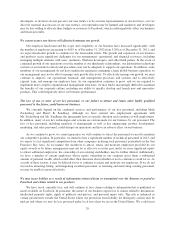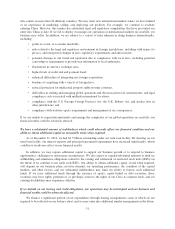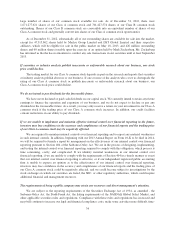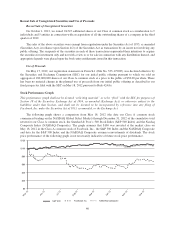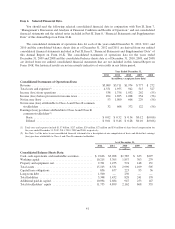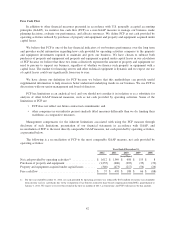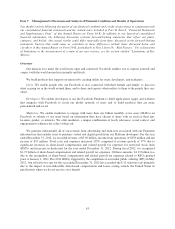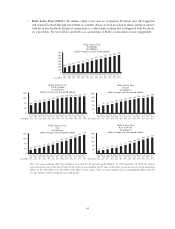Facebook 2012 Annual Report Download - page 39
Download and view the complete annual report
Please find page 39 of the 2012 Facebook annual report below. You can navigate through the pages in the report by either clicking on the pages listed below, or by using the keyword search tool below to find specific information within the annual report.consuming, or costly, and increase demand on our systems and resources. As a result, management’s attention
may be diverted from other business concerns, which could harm our business and operating results. Although
we have hired additional employees to comply with these requirements, we may need to hire more employees in
the future, which will increase our costs and expenses.
In addition, complying with public disclosure rules makes our business more visible, which we believe may
result in threatened or actual litigation, including by competitors and other third parties. If such claims are
successful, our business and operating results could be harmed, and even if the claims do not result in litigation
or are resolved in our favor, these claims, and the time and resources necessary to resolve them, could divert the
resources of our management and harm our business and operating results.
The dual class structure of our common stock and the voting agreements among certain stockholders have the
effect of concentrating voting control with our CEO, and also with employees and directors and their
affiliates; this will limit or preclude your ability to influence corporate matters.
Our Class B common stock has ten votes per share, and our Class A common stock has one vote per share.
Stockholders who hold shares of Class B common stock, including our executive officers, employees, and
directors and their affiliates, together hold a substantial majority of the voting power of our outstanding capital
stock. Because of the ten-to-one voting ratio between our Class B and Class A common stock, the holders of our
Class B common stock collectively control a majority of the combined voting power of our common stock and
therefore are able to control all matters submitted to our stockholders for approval so long as the shares of
Class B common stock represent at least 9.1% of all outstanding shares of our Class A and Class B common
stock. This concentrated control will limit or preclude your ability to influence corporate matters for the
foreseeable future.
Future transfers by holders of Class B common stock will generally result in those shares converting to
Class A common stock, subject to limited exceptions, such as certain transfers effected for estate planning or
charitable purposes. The conversion of Class B common stock to Class A common stock will have the effect,
over time, of increasing the relative voting power of those holders of Class B common stock who retain their
shares in the long term. If, for example, Mr. Zuckerberg retains a significant portion of his holdings of Class B
common stock for an extended period of time, he could, in the future, continue to control a majority of the
combined voting power of our Class A common stock and Class B common stock.
We have elected to take advantage of the “controlled company” exemption to the corporate governance rules
for NASDAQ-listed companies, which could make our Class A common stock less attractive to some investors
or otherwise harm our stock price.
Because we qualify as a “controlled company” under the corporate governance rules for NASDAQ-listed
companies, we are not required to have a majority of our board of directors be independent, nor are we required to
have a compensation committee or an independent nominating function. In light of our status as a controlled
company, our board of directors determined not to have an independent nominating function and chose to have the
full board of directors be directly responsible for nominating members of our board, and in the future we could elect
not to have a majority of our board of directors be independent or not to have a compensation committee.
Accordingly, should the interests of our controlling stockholder differ from those of other stockholders, the other
stockholders may not have the same protections afforded to stockholders of companies that are subject to all of the
corporate governance rules for NASDAQ-listed companies. Our status as a controlled company could make our
Class A common stock less attractive to some investors or otherwise harm our stock price.
Delaware law and provisions in our restated certificate of incorporation and bylaws could make a merger,
tender offer, or proxy contest difficult, thereby depressing the trading price of our Class A common stock.
Our status as a Delaware corporation and the anti-takeover provisions of the Delaware General Corporation
Law may discourage, delay, or prevent a change in control by prohibiting us from engaging in a business
35






